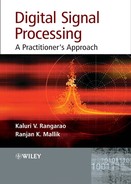Preface
There are many books on the subject of digital signal processing, but I have not come across any that cater for practising engineers and beginners. This book aims to meet the needs of people who wish to grasp the concepts and implement them. Without compromising the analytical rigour behind the concepts, it takes you smoothly from grasping the ideas to implementing them for yourself.
Digital signal processing (DSP) is practised by people of all disciplines. Historically, seismologists did major research using DSP, particularly on earthquake prediction. Statisticians such as Box and Jenkins used DSP to study the flow of rivers in North America, finding that they provided an easy way for merchants to transport logs from the mountain forests to the foothills.
Only recently have communications engineers begun using DSP. And it's even more recently that DSP has been embraced by military personnel, space scientists, bankers, stockbrokers, clinical doctors and astronomers, with the famous example of predicting sunspots. In his April 1987 paper ‘Challenges to Control in Signal Processing and Communications’ (Control Systems Magazine, 7(2), 3–6) Willsky has presented an interesting perspective on unifying the concepts of control, communication, statistics and systems engineering. Enthusiastic readers are advised to consult it.
I have written this book with the mindset of a hardcore electrical engineer, always attempting to translate information into a piece of hardware worthy of implementation. The aim is to make the understanding of DSP as simple as possible as well as readable by beginners and experts alike. I chose as a role model India's great creative genius and scholar Annamayya, who bundled all the complex philosophies into simple and lucid language within the understanding of the layman, the common man. Each chapter is self-contained and can be read on its own.
This book is a compendium of several lectures I have delivered on this subject to a variety of audiences during a decade at the Naval Laboratories in Visakapatnam, two years at the Naval Postgraduate School in California, five years at the Electronics Research Laboratory in Hyderabad, five years at the Research Center Imarat, five years of industry experience at Satyam Computer Services Ltd, Hyderabad, and one year with General Electric at Begumpet, Hyderabad.
It has been refined over the years by many in-depth discussions with associates, professional colleagues and distinguished persons. I also owe a lot to my master's degree students, who came to me for guidance with their dissertations.
Many lunch and teatime discussions have enriched my perspective on the subject. These experiences have left lasting memories, so much so that I felt it was my duty to write this book, and within my limited wisdom and understanding, to take the things I had learned and pass them on in my own language, blended with my own experience.
This book has six chapters. Chapter 1 introduces the processing of signals. Chapter 2 revisits the basics for understanding DSP. Chapter 3 is on digital filters. Chapter 4 deals with fast Fourier transforms. Chapter 5 gives various hardware schemes for implementation and looks at embedded systems; it gives pointers for very large scale integration (VLSI). The case studies in Chapter 6 give a flavour of some applications for practising engineers.
Kaluri Venkata Rangarao
